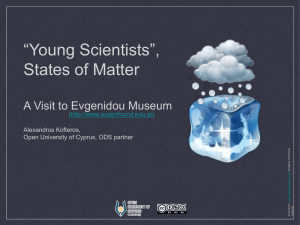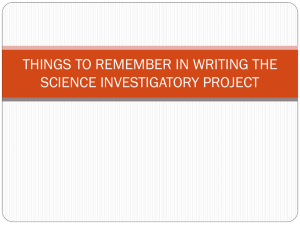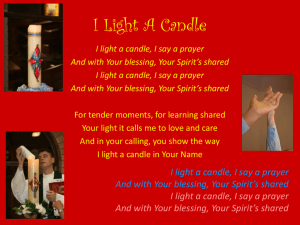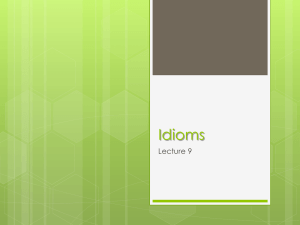How does temperature affect the rate at which a candle burns?
advertisement
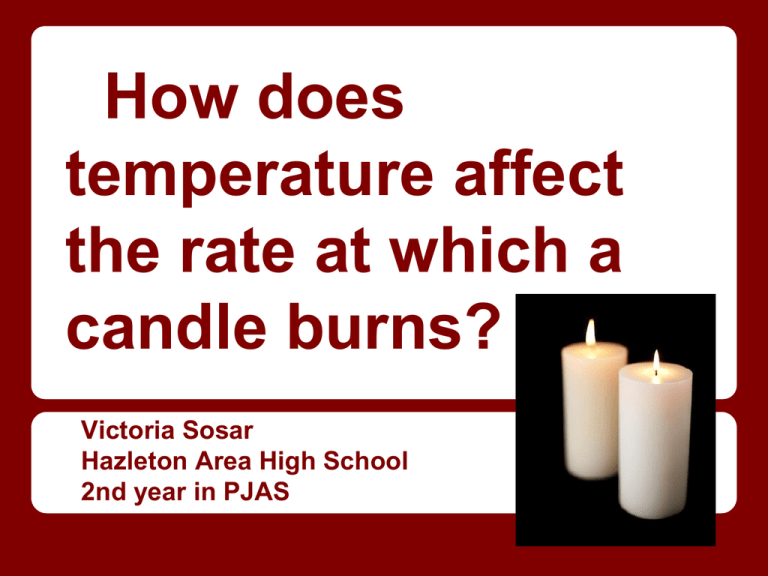
How does temperature affect the rate at which a candle burns? Victoria Sosar Hazleton Area High School 2nd year in PJAS Background information -The wick of a candle is usually made of an absorbent twine, and must have strong capillary action (which means the wick needs to be able to absorb melted wax and move it up while the candle burns.) -Paraffin wax is made of a heavy hydrocarbon that is comes from crude oil. -The third temperature will be the ice/salt bath. when ice and salt are mixed the salt melts the ice to a small degree but also makes the temperature below zero degrees. -An infrared thermometer was used to take the temperature of the candle because research showed it was the most accurate to take temperatures off Objective - The objective of this experiment is to find the relationship comparing the temperature of a candle and at which the rate it burns. Hypothesis -The hypothesis for this experiment is that the candle will burn slower the coldest conditions. Materials used in experiment -8 identical,unscented candles -lighter -Clay putty -balance scale -timer -infrared thermometer -ice cubes -iodized salt -plastic cups -Styrofoam plate Experimental procedure for Temperature 1 (room temperature of 26.0 C) 1.Weigh each candle to find the mass and record each measurement 2. put the clay putty on the bottom of the candles and stick them to the styrofoam plate. Record the temperature of the room. 3. light the candles and let them burn for exactly 20 minutes. 4. blow out the candles and let them stand until they are cooled 5.Once the candle is finally cooled weigh the mass of the candle after the burning. 6.Using the weight of the candle before the burning, and after the burning, and the amount of time the candle was burnt, calculate the burn rate with the mathematical equation. Experimental Procedure for Temperature 2 (ice bath 3.3 C ) 1.(Repeat from the first procedure) 2.Fill 2 clear plastic cups to the top with ice and put the candle in, but allow about 1/4 of the top of the candle to stick out.Let it sit for about 10 minutes 3.(Repeat from the first procedure) 4.(Repeat from the first procedure) 5.Once the candle is finally cooled weigh the mass of the candle after the burning. 6.(Repeat from the first procedure) Experimental Procedure for Temperature 3 (ice/salt bath -10.1 C) 1.(Repeat from the first and second procedure) 2.Fill 2 clear plastic cups to the top with ice and put two tablespoons of iodized salt on top of the ice. put the candle in the cup, but allow about 1/4 of the top of the candle to stick out. let it sit for about 10 minutes. 3.(Repeat from the first and second procedure) 4.(Repeat from the first and second procedure) 5.Once the candle is finally cooled weigh the mass of the candle after the burning. 6.(Repeat from the first and second procedure) Controlled, Independent and Dependent Variables Controlled Variable- The paraffin wax candles Independent Variable- The temperature of the burning conditions Dependent Variable- The burn rate of the candles Mathematical equation to figure out the burn rate of the candle Burn Rate= Initial Mass - Final Mass Initial Time - Final Time Results for Temperature 1 (room temperature of 26.0 C) Candle 1: 19.39 - 17.10 0 - 20 Answer: .1145 g/ min Candle 2: 19.39 - 17.10 0 - 20 Answer: .1145 g/ min Candle 3: 19.39 - 17.12 0 - 20 Answer: .1135 g/ min Results for Temperature 2 (ice bath of 3.3 C) Candle 1: 19.39 - 16.90 0 - 20 Answer: .1245 g/ min Candle 2: 19.39 - 16.91 0 - 20 Answer: .124 g/ min Candle 3: 19.39 - 16.91 0 - 20 Answer: .124 g/ min Results for Temperature 3 (Ice/Salt bath of -10.1 C) Candle 1: 19.39 - 15.83 0 - 20 Answer: .178 g/ min Candle 2: 19.39 - 15.85 Answer: .177 g/ min 0 - 20 Candle 3: 19.39 - 15.85 Answer: .177 g/ min 0 - 20 Comparing Results of Burn Rates Temperatures 26.0 C 3.3 C -10.1 C Possible errors - Not measuring the weight of the ice cubes before using it to make the candles cold. - Future areas of research - testing different types of wax -testing scented wax -testing colored wax Sources http://www.candlescience.com/faq/11/generalcandle-making/how-to-calculate-burn-time/ http://home.howstuffworks.com/question267.htm http://candleandsoap.about.com/od/candlemaking basics/tp/typesofcandlewaxes.htm http://www.grainger.com/Grainger/static/handheldinfrared-thermometers-370.htm


